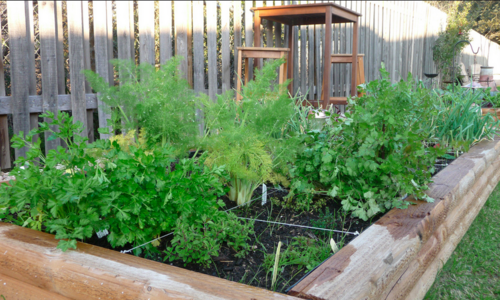
Designing a herb garden is a part of the joy of growing herbs. There are many ways to put together a herb garden, from orderly to random and everything in between. This article intends to help growers with a range of ideas for designing herb gardens by outlining the various possible herb garden designs and grow tents, and you are encouraged to build on existing suggestions or add more of your own ideas here.
Kitchen herb garden
For keeping key herbs used frequently close to the kitchen area or an entrance/exit area of the house close to the kitchen. Such herbs could include:
- Parsley
- Rosemary
- Basil
- Sage
- Thyme
- Chives
- Mint
- Borage
- Sweet cicely.
Culinary herb garden
Larger than a kitchen herb garden. This can be suitable for both kitchen use and commercial use for a cafe or restaurant wishing to grow its own fresh herbs either in a windowsill or in a garden patch.
Suitable herbs might include:
- Parsley
- Rosemary
- Basil, different varieties
- Sage
- Thyme
- Chives
- Mint, different varieties.
Medicinal herb garden
For growing a wide range or a specific range of medicinal herbs. The herbalist will need to know which herbs are needed for his or her desired medicinal use before planting.
Tea herb garden
Formed with herbs that can be turned into teas. This refers to herbal teas (or tisanes), which can be augmented with black tea leaves in some cases, or mostly consumed in their own right.
Some suggestions include:
- Peppermint and spearmint
- Chamomile
- Echinacea
- Bee balm
- Elderberry
- Dill
- Lemongrass
- Rosehip
- Verbena.
Knot garden formed by herbs
Some herbs lend themselves well to growing into each other, a fact that can be used by the creative gardener to form designs, such as traditional knotwork. When looked from above, a lovely pattern forms.
Children's herb garden
For teaching children about growing plants, especially herbs and to learn about using the herbs after harvesting. It is ideal to focus on herbs that are easy to grow and can be enjoyed by the children in one form or another.
One idea for a child's herb garden is grow a "pizza garden", in which herbs used on pizza feature. The child learns which herbs go well with pizza, then plants them. After the herbs have grown, the child gets to harvest the herbs and make a pizza (with help, as needed), using the freshly picked herbs to improve the pizza's flavour. Suitable herbs include oregano, rosemary, chives, basil and thyme. It can be varied a bit with the addition of tomatoes, capsicums (bell peppers) and onions, to grow as many of the pizza toppings as possible!
Companion animal or wildlife herb garden
A herb garden focused on pleasing the companion animals of the household, such as catnip for cats and grass for various pets to chew on. Or, it can be grown for local wildlife, if preferred.
This type of garden can be viewed in two ways. One, it can be grown purely for the pleasure of the companion animals or wildlife to enjoy and roam through at leisure, sniffing, chewing on, rolling on and sleeping among the herbs, etc. Second, it could be grown with aims in mind such as producing herbs to make animal medicines, flea treatments, grooming supplies, etc. Or, mix both.
Key to this type of herb garden is ensuring that the animals can access it with ease and that you are absolutely certain that the plants it contains are safe for the intended animals.
Insect repellent herb garden
This garden focuses on producing herbs that can be used to create insect repellents in various forms such as sachets, potpourri, sprays, etc.
Flowers and herbs herb garden
A combination of edible, medicinal and useful flowers combined with herbs of choice.
Period herb garden
A herb garden reflective of a particular period in history displaying herbs popular during that period. A good one for the history buffs, it's also an excellent garden for rediscovering long forgotten herbs and possibly enthusing your neighbours into doing the same. This garden can be even more enjoyable when coupled with period dinner parties using the herbs to cook foods of the period.
Fragrant herb garden
A herb garden filled with highly scented herbs, for culinary and pleasure purposes.
Dye herb garden
This garden focuses on herbs that can produce dyes to be used in household production and on the person.
Everlasting herb garden
Filled with herbs that are perennials and that can be dried to be included in floral arrangements or hung in the pantry for later use (preferably without losing their taste or medicinal properties).